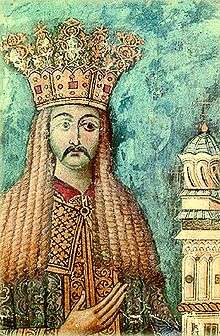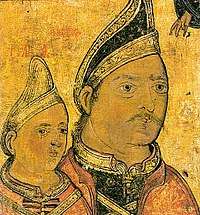Neagoe Basarab
Neagoe Basarab (Romanian pronunciation: [ne̯aˈɡo.e basaˈrab]), (1459 – 15 September 1521) was the Voivode (Prince) of Wallachia between 1512 and 1521. Born into the boyar family of the Craioveşti (his reign marks the climax of the family's political influence) as the son of Pârvu Craiovescu or Basarab Țepeluș cel Tânăr, Neagoe Basarab, who replaced Vlad cel Tânăr after the latter rejected Craioveşti tutelage, was noted for his abilities and competence.
| Neagoe Basarab V | |
|---|---|
| Voivode of Wallachia | |
 | |
| Voivode of Wallachia | |
| Reign | 23 January 1512 – 15 September 1521 |
| Predecessor | Vlad cel Tânăr |
| Successor | Teodosie of Wallachia |
| Born | 1459 |
| Died | 15 September 1521 (aged 62) |
| Burial | |
| Spouse | Milica Despina of Serbia |
| Issue | Teodosie of Wallachia Ioan Petru Stana of Wallachia Angelina of Wallachia Ruxandra of Wallachia |
| House | House of Craiovești |
| Father | Pârvu Craiovescu or Basarab Țepeluș cel Tânăr |
| Mother | Doamna Neaga |
| Religion | Eastern Orthodox Church |
St. Neagoe Basarab | |
|---|---|
 Neagoe Basarab, Milica Despina and his children pictured on the murals of the Curtea de Argeş Monastery | |
| Voivode of Wallachia | |
| Venerated in | Romanian Orthodox Church |
| Canonized | 2008-07-08, Bucharest by the Holy Synod of the Romanian Orthodox Church[1] |
| Feast | 26 September |
| Attributes | hesychast and prince of peace |
| Patronage | Romania |
Reign

(icon from the Dionysiou monastery)
In the 16th century, Wallachia was independent, but was required to pay an exorbitant tribute to the greater force of the Ottoman Empire. Neagoe encouraged the development of crafts and trade, while maintaining a good relation with Wallachia's other powerful neighbour, Hungary.
His diplomacy attempted to establish connections with the Republic of Venice and the Papacy, even offering to mediate the dispute between Eastern Orthodoxy and Roman Catholicism, with the purpose of uniting Christendom against the Ottoman threat.
He adopted the Byzantine tradition of Church patronage, making generous donations to the Orthodox monasteries, not only in Wallachia but throughout the Balkans. During his reign the Curtea de Argeş Monastery was built (in 1517) – legend names Meşterul Manole as the chief craftsman; the account also fuses Neagoe with yet another legendary figure, Prince Radu (who would've caused Manole's death by ordering for the scaffolding to be removed while the builders were on the roof, ensuring that nobody would use Manole's craft, and thus preserving the uniqueness of the structure).
Neagoe ordered the earliest works on the old Metropolitan church in Târgovişte (the city where the edition of the Gospels was published in 1512) and St. Nicholas Church in Şcheii Braşovului.
Neagoe Basarab wrote in Church Slavonic one of the earliest literary works of Wallachia, called "The teachings of Neagoe Basarab to his son Theodosie" (translated in Romanian as Învăţăturile lui Neagoe Basarab către fiul său Teodosie), where he touches various subjects such as philosophy, diplomacy, morals and ethics.
Family
He married Milica Despina, daughter of Serbia. Among their children are Teodosie of Wallachia and Ruxandra, wife of Radu of Afumați and Radu Paisie, both princes of Walachia.
Neagoe Basarab House of Craiovești Born: 1462 Died: 1508 | ||
| Regnal titles | ||
|---|---|---|
| Preceded by Vlad cel Tânăr |
Voivode of Wallachia 1512–1521 |
Succeeded by Teodosie |
| Wikimedia Commons has media related to Neagoe Basarab. |
Literature
Grigore, Mihai-D., Neagoe Basarab - Princeps Christianus. Christianitas-Semantik im Vergleich mit Erasmus, Luther, Machiavelli (1513-1523). Frankfurt M.: Peter Lang 2015. 433p.
Notes
- "Trecerea în rândul sfinţilor a domnitorului Neagoe Basarab, a lui Dionisie cel Smerit si a mitropolitului Iachint de Vicina" (in Romanian). Basilica (Romanian Orthodox Church news agency). 2008-07-08. Archived from the original on 2008-12-07. Retrieved 2008-07-09.